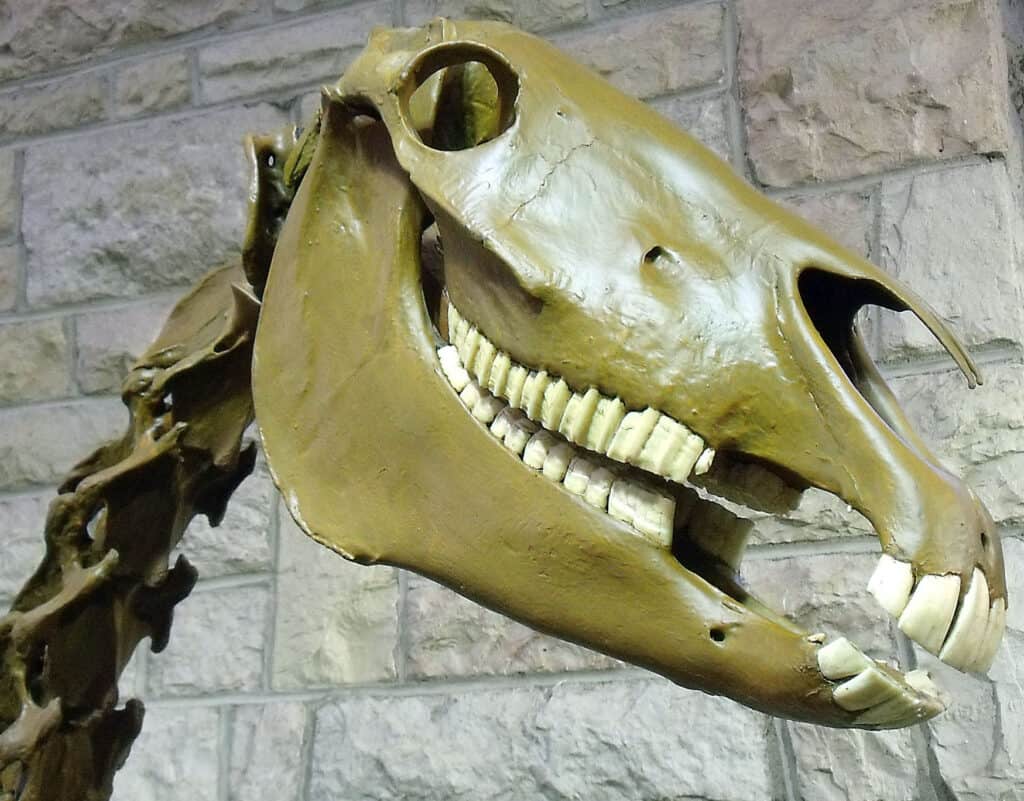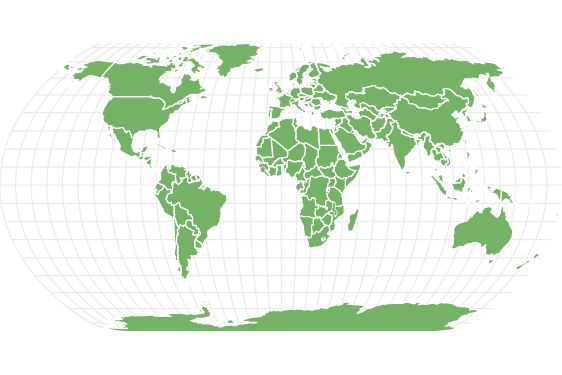Equus giganteus is the largest species of horse that has ever lived.
Advertisement
Equus giganteus Scientific Classification
- Kingdom
- Animalia
- Phylum
- Chordata
- Class
- Mammalia
- Order
- Perissodactyla
- Family
- Equidae
- Genus
- Equus
- Scientific Name
- Equus giganteus
Read our Complete Guide to Classification of Animals.
Equus giganteus Conservation Status
Equus giganteus Facts
- Fun Fact
- Equus giganteus is the largest species of horse that has ever lived.
- Biggest Threat
- Climate change
- Most Distinctive Feature
- The giant horse had massive teeth
- Other Name(s)
- Giant horse
- Habitat
- Grasslands and prairies of North America
- Predators
- Carnivorous mammals like the American Lion, saber-toothed cats, and short-faced bears
- Diet
- Herbivore
- Favorite Food
- Grass
- Type
- Prehistoric giant horse
- Common Name
- Giant horse
- Origin
- North America
- Number Of Species
- 1
Equus giganteus Physical Characteristics
- Weight
- 2600-3300lbs
- Height
- 6.6ft
- Venomous
- No
- Aggression
- Medium
View all of the Equus giganteus images!
Whether domesticated or you happen to catch a glimpse of wild horses running in the fields, most people would agree that horses are among the most majestic creatures. Like most animals today, the prehistoric version of modern-day horses used to be bigger and even more majestic. Perhaps the biggest of them all was the Equus giganteus. This extinct horse species lived in North America until it became extinct about 12,000 years ago. Most of the other large mammals living on the continent at the time also became extinct. The giant wild horse was bigger than today’s horses. It is still quite similar in terms of overall appearance and habits.
Description and Size

Equus giganteus probably stood at about 6.6 feet tall. The estimate of the species’ size is based on a single-tooth fossil which was found to be bigger than the teeth of the largest draft horses today.
©Mike Beauregard / Creative Commons Attribution 2.0 Generic license. – License
Equus giganteus is an extinct species of horse that lived during the Blancan Period (a period which coincides with the early Pliocene Epoch of the geologic time scale) till about 12,000 years ago towards the end of the Pleistocene Epoch. The name of this horse translates as “giant horse.” It is fitting, considering it was a much bigger version of present-day horses.
Horses are typically measured at the withers, the small hump at the base of their head. Measured at the shoulders like this, Equus giganteus probably stood at about 6.6 feet tall. The estimate of the species’ size is based on a single-tooth fossil. It was found to be bigger than the teeth of the largest draft horses today. Scientists think there’s a chance this horse might have been bigger than this since we’re not sure whether or not the tooth fossil belonged to a juvenile or an adult horse.
The giant horse was not just tall. It was heavy too. Estimates of its weight show it had a mass of about 2,600–3,300 pounds. This is significantly bigger than a shire horse, the largest horse breed today. Shire horses weigh about 2,500 pounds on average. This means the smallest giant horse would have been bigger than some of the biggest shire horses today.
Appearance
Due to the fragmentary nature of the fossils of this species found so far, it has been difficult to reconstruct how the head and the rest of this horse’s body might have looked. However, we can make some good guesses based on some living breeds that are closely related.
The Przewalski’s horse is one good example we can look at to get an idea of how this horse might have looked. This breed is stockily built and has a big solid head. The Equus giganteus was probably a mealy horse, with the color of its muzzle being paler than its coat, while its lower legs had a darker color. It’s also likely that they had a dark line of hair (dorsal stripe) running down their backs, as is seen in many modern breeds with old ancestry.
Diet—What Did Equus giganteus Eat?
We do not know for sure what the giant horse ate while it was alive, but it was probably not remarkably different from the diet of modern breeds. It was obviously an herbivore that fed in the grasslands of Pleistocene America.
Habitat—When and Where It Lived
Equus giganteus thrived in the great grasslands and prairies of the western USA during the Pleistocene epoch. However, the species most likely evolved much earlier during the Pliocene (about 2.5 million years ago). Experts believe horses evolved in North America before moving down south about 1.5 million years ago.
Interestingly, modern North American Horses are not direct descendants of the ancient varieties. All American wild horse species died off about 12,000 years ago during the great American extinction. Today’s horses were bred from horse species imported to the Americas from Europe in the 16th century.
Threats and Predators
The fauna of North America during the Pleistocene included predators such as the short-faced bears, American lion (Panthera atrox), Panthera onca augusta (a type of giant jaguar, and the saber-toothed cats (Smilodon fatalis). Although the giant horse was bigger than present-day horses, these predators were equally massive in size and probably attacked it. The Pleistocene Epoch was also a difficult time environmentally. A major ice age occurred towards the end of the epoch, and the environmental changes it brought led to the disappearance of many of the megafaunas of North America.
Discoveries and Fossils—Where Equus giganteus Was Found
The first fossil of the giant horse was found as early as I826. They were teeth and vertebrae bones found near the Neversink Hills in New Jersey. However, the fragmented nature of the fossils made it difficult to assign them to any species. Over the years, many more materials were recovered from different localities in the United States and Mexico, but they were too incomplete for accurate classification. Different scientists have proposed up to twenty separate species.
In the summer of 1899, J. W. Gidley discovered some bones in lower Pleistocene beds. The fossil was in excellent condition, and earlier studies named the species Equus scotti. However, after further studies, Gideley proposed a revision and renamed the species Equus giganteus in 1901.
Extinction—When Did Equus giganteus Die Out?
It’s difficult to tell when the giant North American horse went extinct or the factors that led to its disappearance. However, scientists often link their disappearance to the extinction that wiped out most of the large mammals living in North America during the Pleistocene. The main factor responsible for the extinction was the shift in climatic conditions, which changed the nature of vegetation available for these herbivores to feed on.
Shortly after the last ice age, high protein plants (C3 vegetations) that were once abundant in America disappeared and were replaced by coarser and difficult-to-digest varieties (C4 plants). This new diet could not sustain many species living on the continent due to their large size and unique nutritional requirements. This may have caused the disappearance of the E. giganteus.
Another theory that explains their extinction is the arrival of native North American people. The Clovis tribe, in particular, arrived in this region about 13,000 years ago, and they’re known for their lethally sharp weapons. They probably hunted many of the large mammals of the time to extinction, and the giant horse was on the menu too. Human activities such as bush burning and deforestation may have also contributed to the horse’s disappearance.
Similar Animals to the Equus giganteus
Similar animals to the Equus giganteus include:
- Equus africanus africanus — Known commonly as the Nubian wild ass, it is a subspecies of the African wild ass and an ancestor of the domestic donkey.
- Przewalski’s horse — The Mongolian wild horse is a rare horse breed native to Asia. It has a stocky build but is smaller and shorter than its closest domesticated relatives.
- Shire horse — The Shire horse is a British breed of draught horse. It is considered the biggest living horse breed in the world.
Related Animals
- Canadian Horse
- This Gigantic Ancient Horse Weighed 3,000lbs and Towered Over Draft Horses
- Horse
- Tennessee Walking Horse
Equus giganteus FAQs (Frequently Asked Questions)
When was the Equus giganteus alive?
Equus giganteus lived between the early Pliocene and Pleistocene epochs. The species probably went extinct about 12,000 years ago, towards the end of the Pleistocene Epoch.
How big was Equus giganteus?
Equus giganteus is one of the largest horse species to have ever lived. It weighed about 2600–3300 pounds and was up to 6.6 feet tall at the shoulders.
What is the largest extinct horse?
Equus giganteus is the largest known species of horse. It was larger than both extinct and living horse breeds.
Thank you for reading! Have some feedback for us? Contact the AZ Animals editorial team.
Sources
- Dinopedia, Available here: https://dinopedia.fandom.com/wiki/Equus_giganteus
- Twilight Beasts, Available here: https://twilightbeasts.org/2017/07/07/the-stuff-of-night-mares/
- Wikipedia, Available here: https://en.wikipedia.org/wiki/Equus_giganteus

















